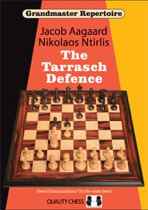Tarrasch Defense, The
Jacob Aagaard, Nikolaos Ntirlis

The Tarrasch Defense by Jacob Aagaard and Nikolaos Ntirlis fills a much-needed gap in the chess literature as it offers the first comprehensive guide to this opening in English. The two authors have done an outstanding job of not only explaining the basic themes and plans that are typical of this opening but also extensively analyzing the theory in detail, offering many important improvements.
The Tarrasch (1.d4 d5 2.c4 e6 3.Nc3 c5) has always been an appealing choice for those looking for easy piece play and one-stop shopping against 1.d4, 1.c4 and 1.Nf3. If White opens with the first two he has little choice but to accept Blacks invitation to the Tarrasch or play something without any punch. Traditionally the champions of the Tarrasch, Spassky and Kasparov, played 1.d4 d5 2.c4 e6 3.Nc3 c5 4.cxd5 exd5 5.Nf3 Nc6 6.g3 Nf6 7.Bg2 Be7 8.0-0 0-0 9.Bg5 cxd4, but the authors have something different in mind. They recommend 9…c4! Those of a certain age might remember German GM Pflegers win over Polugaevsky with this move in the 1978 Chess Olympiad in Buenos Aires, but 9…c4! never really caught on. Here is predicting it will thanks to this book. Not only do the authors recommend …c4 against 9.Bg5, this unbalancing move is often their choice when facing less critical systems.
One of the great virtues of The Tarrasch Defense is the coverage it gives to sidelines other than 6.g3. These lines, particularly where White captures early on …c5, are not well-covered in theory but are seen surprisingly often at the amateur level and Aagaard and Ntrilis have done a most useful service in analyzing them in detail.
The Tarrasch is an excellent opening for players at all levels and provides useful lesson in learning how to play with an isolated pawn. Like the Open variation of the Ruy Lopez it provides a classical education in the value of active piece play.
This cleanly laid out and well bound book is an important contribution to opening theory and is highly recommended, without reservation.
The index of variations covered:
1.d4 d5 2.c4 e6 3.Nc3 c5 4.cxd5 exd5 5.Nf3 Nc6 6.g3 Nf6 7.Bg2 Be7 8.00 00 9.Bg5 c4!
1 Various 10th Moves 21 2 Various 11th Moves 40 3 11.Rc1 49 4 11.e3 59 5 11.f4 74 6 11.Nxc6 and 11.b3 89 7 16.Rc1! 101 8 16.Qc2 116
1.d4 d5 2.c4 e6 3.Nc3 c5 4.cxd5 exd5 5.Nf3 Nc6 6.g3 Nf6 7.Bg2 Be7 8.00 00 9.dxc5 Bxc5 9 Minor 10th Moves 131 10 Reti Variation 144 11 10.Bg5 162 12 Timman Variation Introduction 182 13 Timman Variation Main Line 195 1.d4 d5 2.c4 e6 3.Nc3 c5 4.cxd5 exd5 5.Nf3 Nc6 6.g3 Nf6 7.Bg2 Be7 8.0-0 0-0
14 9th Move Alternatives 218 Early Deviations 15 Set-ups without Nc3 234 16 Various 6th Moves 255 17 6.dxc5! Introduction and 9.Bd2 269 18 6.dxc5! 9.Qd2 285 19 Various 5th Moves 307 20 Various 4th Moves 319
